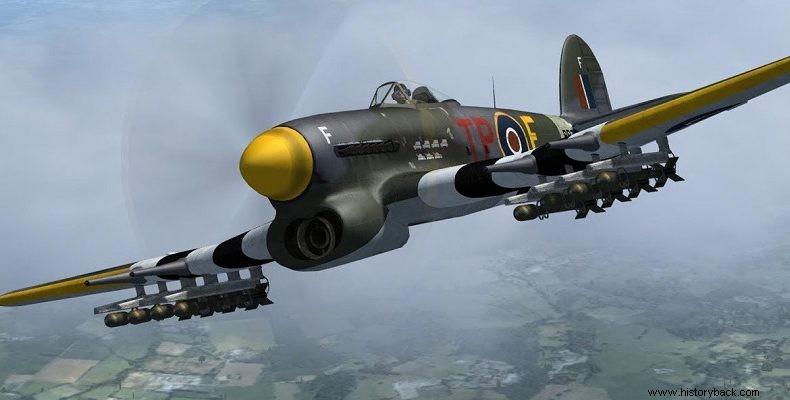
The Hawker Typhoon was supposed to be designed as a replacement for the famous Hawker Hurricane fighter. Equipped with four 20mm guns. and equipped with the 2,200 hp Napier Saber 24-cylinder engine, the aircraft could develop a maximum speed of 652 km per hour and fly at a height of up to 10,360 m
Their radius of action reached 820 km. In theory it was superior in performance even to the famous Spitfire.
But it turned out that at high altitudes the aircraft did not perform well and so it was decided to be used as a close support aircraft, hitting targets on the ground.
Thus the 'tiffie' as it was called by the pilots who flew it, was converted into a fighter, being capable of carrying two 500 or one 1,000 pound bombs or eight rockets, four on each wing, in addition to four 20mm guns. which anyway brought.
And it was in the role of the close support fighter that the aircraft made history, becoming the fear and terror of German tanks, being able, with ease, to destroy even the Tiger-type "behemoths", as "sardine boxes", as they were called at the time.
The Typhoons were instrumental in the landings and subsequent fighting in Normandy although casualties were heavy as the aircraft flew low and concentrated German anti-aircraft fire. More than 150 Typhoon pilots were killed over Normandy.
On 10 June 1944 it was the four Typhoon squadrons that destroyed the headquarters of the German tank force in France. The attack was carried out by 40 Typhoons which fired 136 rockets, from a height of only 600m. The destruction of the headquarters resulted in the untimely intervention of German armored forces against the Allies in Normandy.
On August 7, 1944, at Mortain, France, the Germans launched a major counterattack with the bulk of their armor against General Patton's forces. Two Typhoons immediately flew to the area, which, despite the thick cloud cover, discovered a German phalanx of 300 tanks and vehicles.
Immediately one aircraft hit the leading tank and the second the last one, trapping the phalanx. It is no coincidence that this day was called "Typhoon day". By the evening of August 7, the Typhoons had flown 294 sorties, dropping a total of 2,088 rockets and 75 tons of bombs against the Germans. The German phalanx was wiped out and the German counter-attack was nipped in the bud. The hurricane hit was a catalyst.
